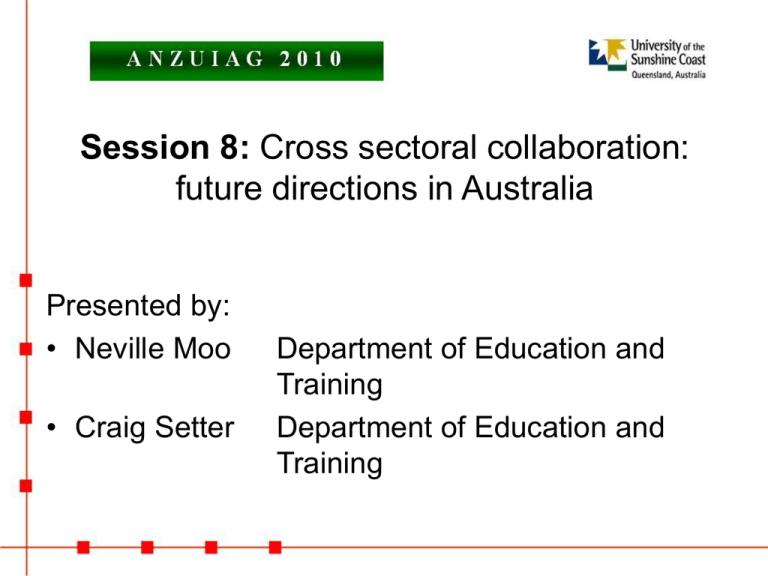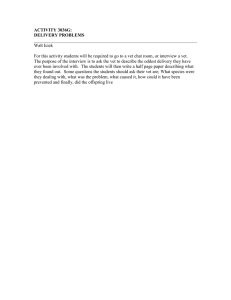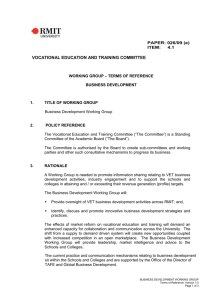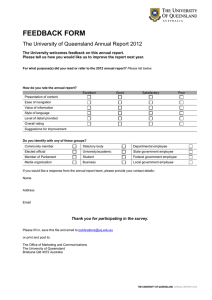Session 8: future directions in Australia
advertisement

Session 8: Cross sectoral collaboration: future directions in Australia Presented by: • Neville Moo • Craig Setter Department of Education and Training Department of Education and Training Cross-Sectoral Collaboration Between Vocational Education and Training (VET) and Higher Education Future Directions in Australia Presenters: Neville Moo – Director, Internal Audit Craig Setter – Manager, Internal Audit ANZUIAG 2010 – Session 8 – Thursday 14 October – 4:00 – 4:45pm Discussion Outline • References • Cross-Sectoral Collaboration : The Difficulties and Benefits (An Introduction) • Recommendations from the 2008 Review into Higher Education in Australia (The Bradley Review) • Federal Government Actions • Cross-Sectoral Collaboration : Now • Cross-Sectoral Collaboration : The Future (A Conclusion) • Handouts Cross-Sectoral Collaboration: The Difficulties and Benefits (An Introduction) “The VET and Higher Education sectors in Australia are governed by different policies and decision-making processes, have different imperatives, are subject to different drivers, pressures and directions, are seeking different outcomes and are accountable in different ways. Such differences are reflected at all levels of both sectors and their institutions. Even when there is a will to collaborate and negotiate cross-sector pathways, the fundamental differences between the sectors present practical as well as philosophical barriers to such pathways.” (Phillips KPA 2006, p12) Cross-Sectoral Collaboration: The Difficulties and Benefits (An Introduction) (Cont’d) Students who have both VET and Higher Education qualifications: • possess a valuable combination of theoretical understanding and critical thinking skills, • possess vocational and technical skills, • are better equipped to play a role in improving the productivity of industry and in addressing issues of sustainability and climate change. More broadly, credit transfer and articulation arrangements are regarded as a means of facilitating lifelong learning and a way of providing access to higher education, especially for those economically disadvantaged. (Cram 2008) Cross-Sectoral Collaboration: The Difficulties and Benefits (An Introduction) (Cont’d) Research also shows that: • such arrangements provide significant benefits to students and the institutions involved, • in some institutions, their most highly articulated courses are the most popular. These institutions also have the highest rate of success in terms of student retention and achievement, with outcomes comparable to or better than the outcomes of all university students. (Cram 2008) Recommendations from the 2008 Review into Higher Education in Australia (The Bradley Review) The Australian Government to: • Adopt a framework for higher education accreditation, quality assurance and regulation. • Establish by 2010, a national regulatory body. • Introduce a demand-driven entitlement system for domestic higher education students. • Expand the national regulatory and quality assurance body to cover the entire tertiary sector. • Take full responsibility for the regulation of tertiary education and training in Australia by 2010. • Negotiate with the states and territories to introduce a tertiary entitlement funding model across higher education and VET. Federal Government Actions • From 2010, the current cap on over enrolment in universities will be raised from 5 to 10 percent. • From 2012 the cap will be removed entirely and universities will be funded on the basis of student demand. • An independent national regulatory and quality agency for Higher Education will be established. • The Government will work with the states and territories to develop strong and cohesive national regulatory arrangements for VET alongside the proposed Higher Education regulator. Federal Government Actions (Cont’d) • The Australian Qualifications Framework Council will be commissioned to improve articulation and connectivity between the university and VET sectors. • The role of Skills Australia will be expanded. • The Government will provide $2m towards a feasibility study into the possible merger of Charles Sturt University and Southern Cross University in order to improve access and support for regional students. Cross-Sectoral Collaboration : Now Despite the Federal Government’s actions and announcements, it does not simply follow that VET and Higher Education will merge or that one sector will take over the other. However, the increased blurring of boundaries between VET and Higher Education is a national event arising directly from the Bradley Report. Existing Dual Sector Universities in Australia • • • • • University of Ballarat Swinburne University of Technology Royal Melbourne Institute of Technology Victoria University Charles Darwin University The University of Ballarat – Swinburne University of Technology Dual-Sector Collaboration Project Discussion Paper • Investigates how dual sector universities can become more cohesive, effective and agile organisations. • There are numerous other organisational models in which VET and Higher Education co-exist, with the outcomes from this project probably applicable to all of them. • The changing Australian political and education environment is driving evolution in this area and that governance arrangements are critical to an effective connection between the two sectors. The University of Ballarat – Swinburne University of Technology Dual-Sector Collaboration Project Discussion Paper (Cont’d) • They explore many of the internal and external governance issues that need to be addressed to ensure the evolution of dual sector universities is not hampered. • Internal and external governance is required to respond to two jurisdictions, Federal and State (and Territory) Governments, which creates a maze of obligations, responsibilities and challenges. Mission and plans, organisational structures, Academic Board dynamics, administrative and corporate support for collaborative educational programs, as well as staffing, personnel and industrial issues must somehow comply with these dual jurisdictional requirements. Proposed Merger between Central Queensland University and Central Queensland Institute of TAFE • One of the most exciting developments in post-school education in Queensland for many years. • Still waiting on the government’s response to the formal proposal. • To run in parallel from the beginning of 2011 and be fully amalgamated by the start of 2012. • 15 campuses from Mackay down to Bundaberg on the coast and west to Barcaldine. Proposed Merger between Central Queensland University and Central Queensland Institute of TAFE (Cont’d) • Offering dovetailed vocational education and higher education courses enabling students to go from certificate level vocational courses through to degrees, masters and doctorate courses and vice versa and for students to undertake vocational training, including apprenticeships, at the same time as tackling a degree course. • Will take higher education into regional communities which had never before had ready access to it. Proposed Merger between Central Queensland University and Central Queensland Institute of TAFE (Cont’d) • DET – the viability of the proposal is still being evaluated. • DET – once analysis is complete, further processes, including evaluation of the service delivery impact on regional Queensland will be completed prior to a decision being made. Cross-Sectoral Collaboration : The Future (A Conclusion) The Higher Education and VET sectors will continue to come together over time especially once the one national regulator TEQSA covers both. However, even then there will still be many barriers to cross. Handouts • • • A Typology of Dual Sector Higher Education and Vocational Education and Training (VET) Providers AUQA Audit Reports on Selected Dual Sector Institutions Summary of the Potential Advantages and Disadvantages of Full Dual Sector Universities







